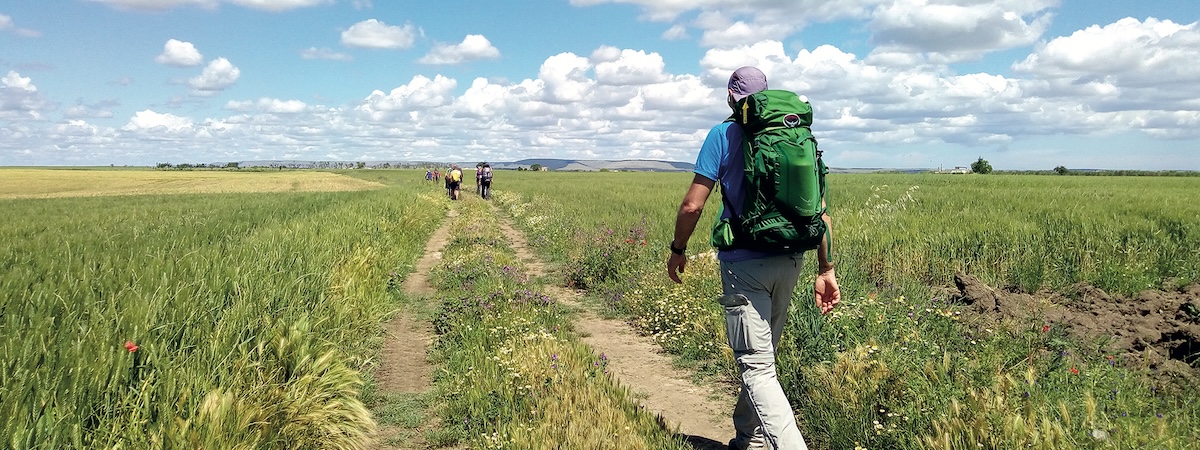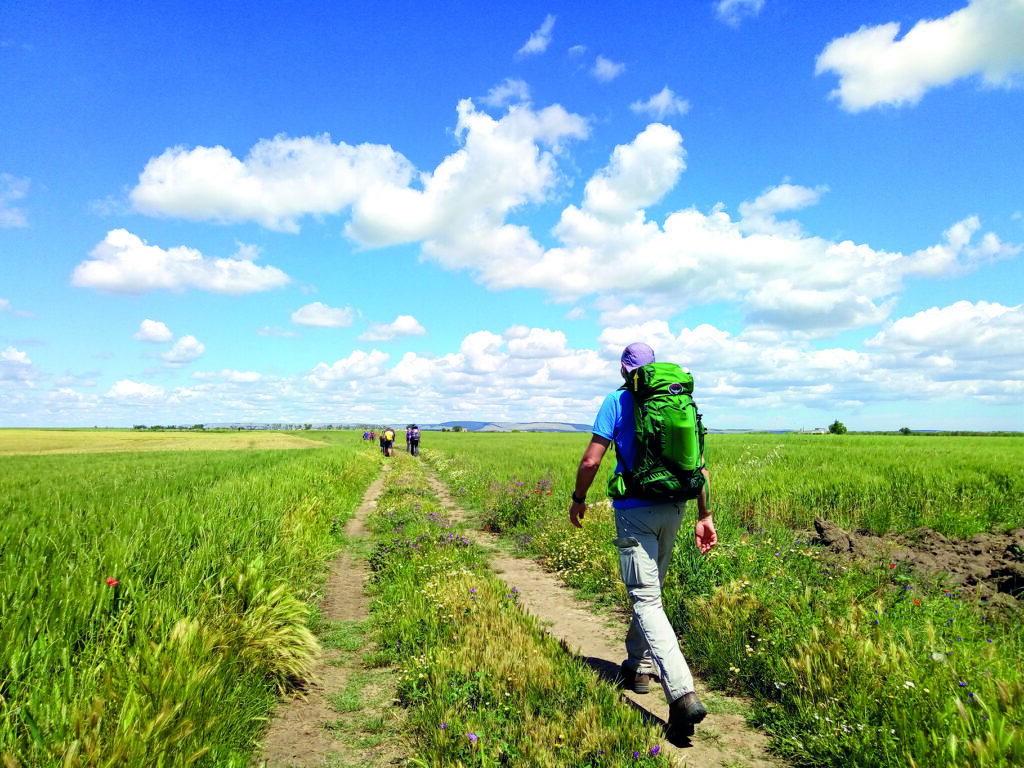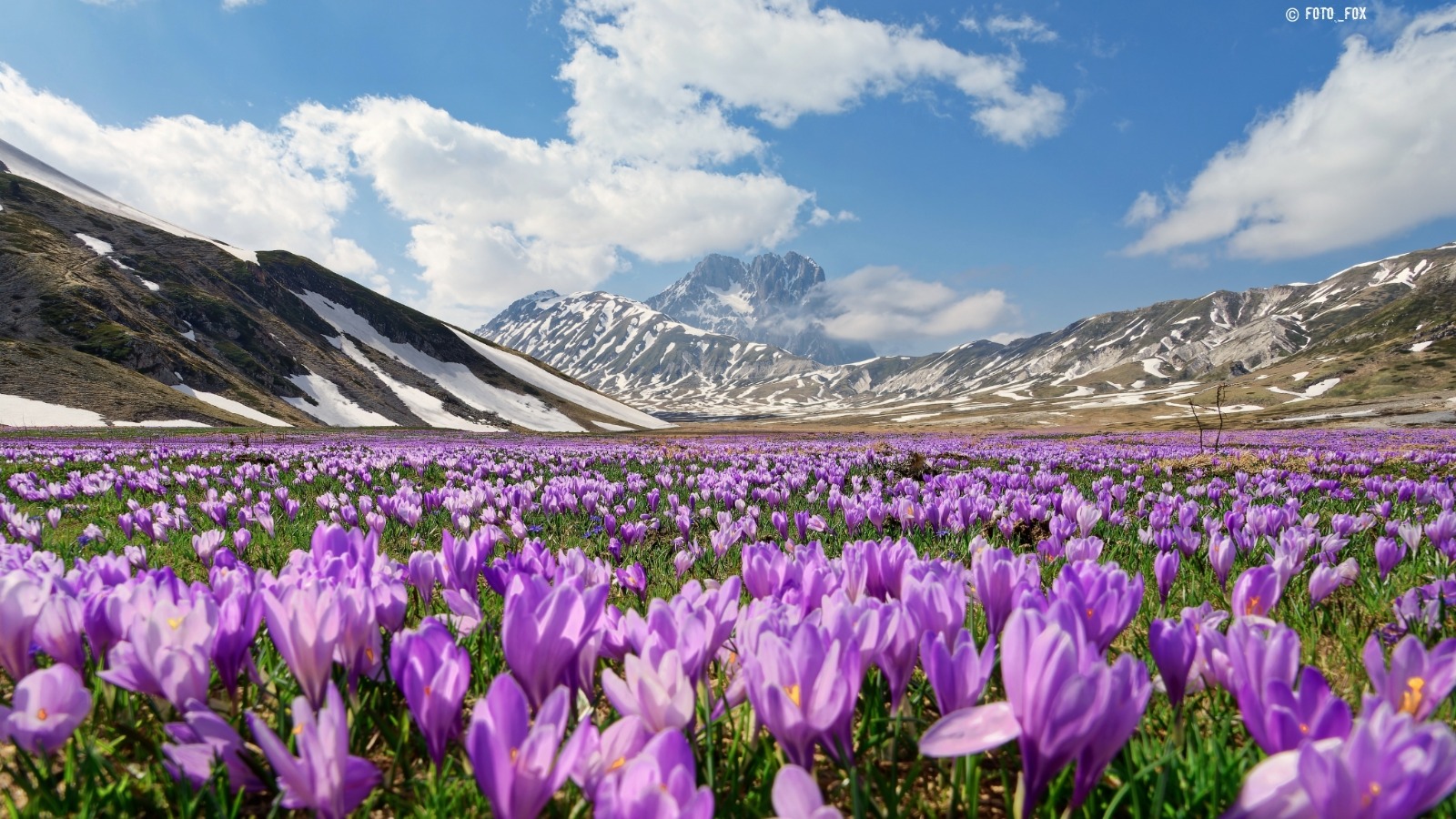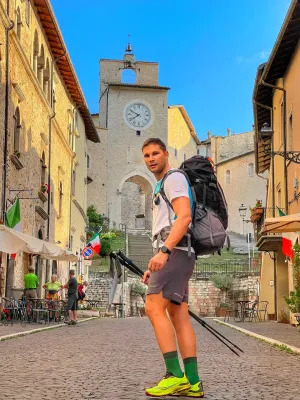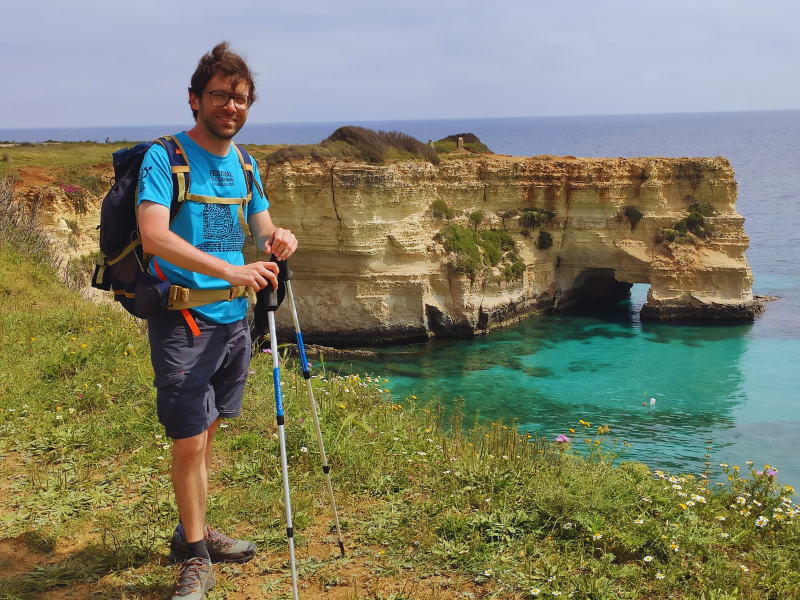Data from the latest dossier, “Italy, Country of Cammini,” produced by Terre di Mezzo in collaboration with Appennino Slow, Walk+, the Cammini d’Italia community and the European Association of Via Francigena, is now in its eighth edition and speaks of a growth in Italian Cammini
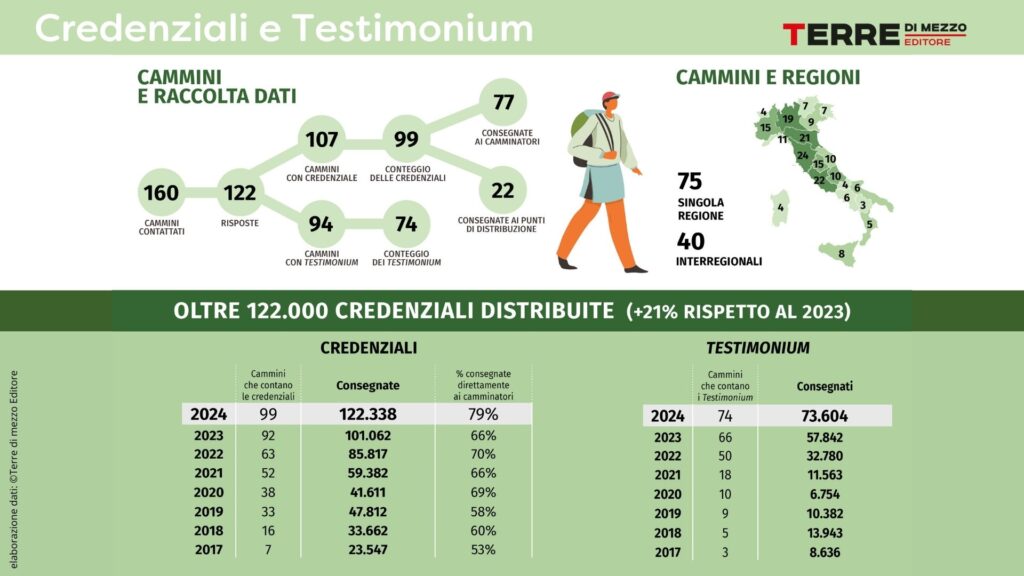
Italy: a people of saints, poets … and walkers. We may not yet be at the levels of Spain, but even in our country there is steady growth: in 2024, almost 200,000 people in Italy would have tackled a Camino. That’ s a 29 percent increase over 2023, when there were about 148,000 walkers (already a 24.4 percent increase over the previous year). It is a clear sign of the interest in a slower, more conscious and sustainable tourism, where immersion in nature and mental and physical well-being are growing priorities.
The data in the dossier, growing steadily
The data come from the dossier “Italy, Country of Cammini, “ produced by Terre di Mezzo in collaboration with Appennino Slow, Walk+, the community of Cammini d’Italia and the European Association of Via Francigena. Now in its eighth edition, the report is based on 4,622 responses collected through an online questionnaire, the monitoring of 160 Cammini (there were 138 in 2023), feedback from the majority of their managers and an analysis of data on Credentials and Testimonium withdrawn.
In 2024, more than 122,000 Credentials were distributed (up 21 percent from 2023) and about 73,000 Testimonium (the documents attesting to the completion of a walk) were issued. The trend has been growing steadily since 2017-excluding the decline in 2020 related to the pandemic-and all indications are that the numbers will grow even more in the coming years, given also the growing narrative of the world of the paths in which the Jubilee year is complicit.
Suffice it to say that in 2017 23,000 Credentials had been handed out, more than doubled in 2021 (almost 60,000!), and then a further doubling last year. And this is despite the fact that weather conditions last year were not so favorable, including priMaverile rains and a particularly hot summer. Considering that about 26 percent of people set out without collecting the Credential-and that not all the Camminos offer them-there we are at the conservative estimate of nearly 200,000 people.
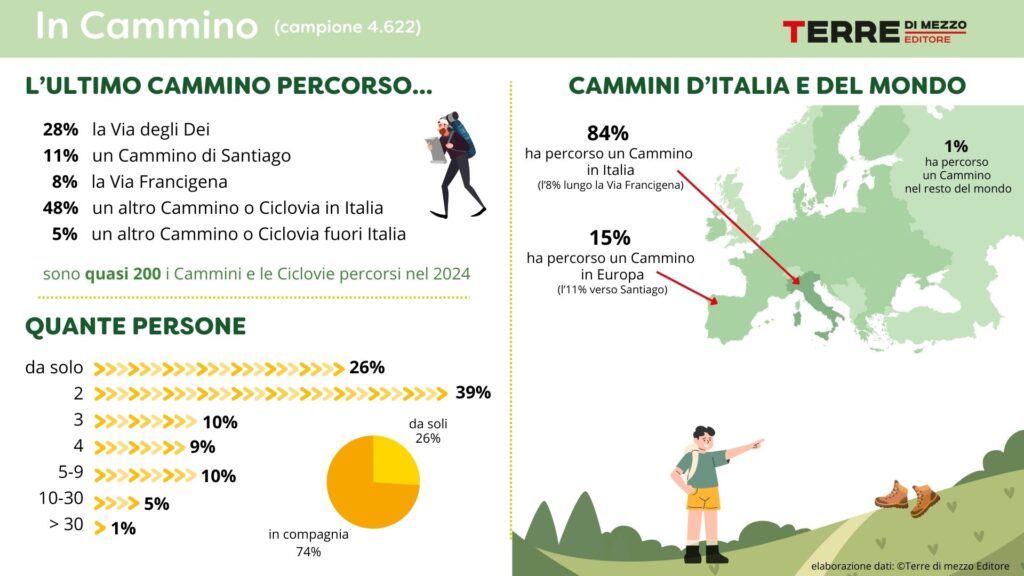
The Paths and Walkers of Italy
All Italian regions are crossed by Camminos: 75 are regional and 40 interregional, particularly in Emilia Romagna, Tuscany and Lazio, followed by Piedmont and Umbria. Eighty-four percent of walkers have tackled a Camino in Italy versus 16 percent abroad (including Caminos de Santiago, 11 percent, and other Caminos, 5 percent): leading the way among the most popular is the Via degli Dei which connects Bologna and Florence, traveled by 28% of walkers, and the Via Francigena, with 8%. Forty-eight percent have walked another Cammino or ciclovia in our country.
But who are the Italian walkers, and where do they come from? According to the data collected, 51% are women, 49% men. The most represented age group is 56-65 (30 percent), followed by 46-55 (22 percent), over 65 (15 percent), 26-35 and 36-45 (both 14 percent), while the remaining 4 percent are under 25. Compared to the Cammino de Santiago de Compostela, where last year nearly 500,000 people arrived at their destination by collecting the Compostela (the equivalent of our Testimonium), walkers in Italy are a few years older: in fact, 32 percent are under 45 years old in Italy, compared to 47.7 percent in Spain; 53 percent are between 46 and 65 years old (compared to 40.5 percent in Spain); and 15 percent are over 65 (compared to 12 percent).
One in 4 people set out alone, the remainder prefer to move in company. Most of them come from northern Italy, including Lombardy (31%), Emilia Romagna (14%), Veneto (13%) and Piedmont (11%). By 2024, almost a third of these people had already walked 2 paths; 23% had walked 3 or more, while 16% made their first walk last year. Many of these people stated that since discovering them they cannot do without them. Who can blame them?
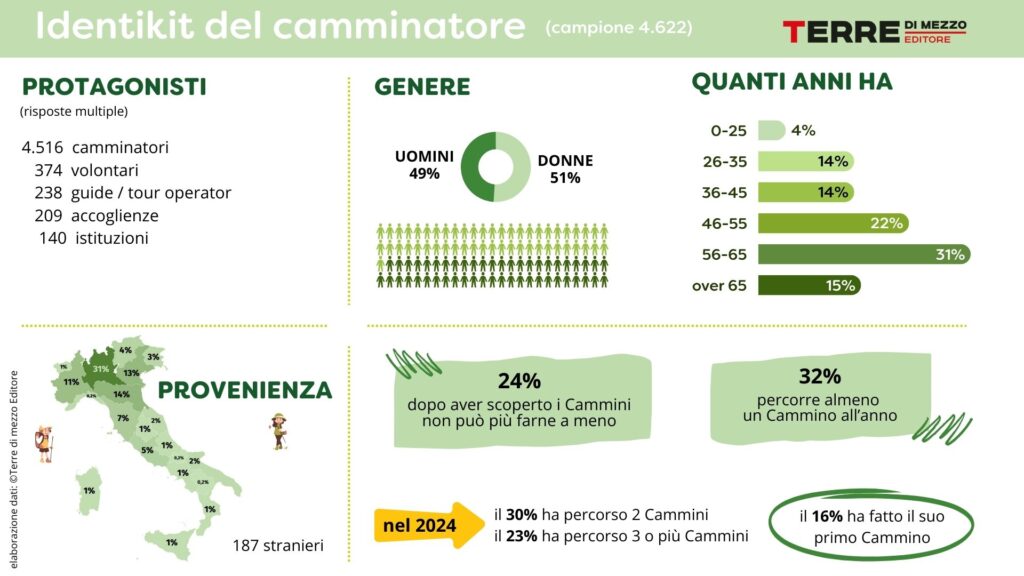
Walkers under 35
These data confirm that walking is still a more mature phenomenon in Italy than in Spain and other countries, but new generations are beginning to emerge. The report thus devotes a focus to young people under 35, who are particularly concentrated along the Via degli Dei. For them, the Camino must be challenging, sharable with friends and, above all, economical (in fact, 30% of those under 25 choose to sleep in tents to save money), and 97% declare as their first motivation the desire to be in the midst of nature.
From the youngest, the Cammino di DANTE routes are discovered mainly by word of mouth, to follow through social media and, to a lesser extent, through the web and podcasts. It is precisely the younger segment that represents a strategic challenge for the future of the Camminos: if territories want to engage young people, accessible hospitality policies, “smart” services and a narrative consistent with their values are needed.
Motivations and habits of Italian walkers
Among the main motivations of those who undertake a walk are, in order: the chance to be in nature, to have an inner experience in search of mental and emotional well-being, the search for physical well-being, the chance to get to know the territory and places never seen before, meet new people, and have new experiences. 85 percent devote part of their day to visiting places, and once they arrive at their destination, more than half of the walkers add a few days of vacation, demonstrating a desire for slower tourism. And 1 in 4 people set out on the Camino for religious or spiritual reasons.
Walking for at least three days and up to one week per year is 23% of walkers. Forty percent are on the trail for 2-4 weeks, and a lucky 22% have been on the trail for 1 to 2 months. And then there are the luckiest 15% who say they spend more than two months a year on the trail along different routes. Compared to 2023 there has been a small decline, dropping from an average of 9 days walking to an average of 7.5. And 3 percent of those who set out on the Camino, particularly in the months between April and September, do not take other vacations besides Walks and Cycle Routes. Nearly half reach their departure by train; a quarter by car, a fifth by plane, while the rest travel by bus, bicycle, boat or on foot.
The Economy of the Paths
Italian Camminos are increasingly moving the economy: pre-departure walkers buy books and guidebooks (47 percent), clothing (40 percent), equipment (39 percent), and shoes (34 percent).
During a walk, 16 percent spend less than 30 euros per day, 55 percent between 30 and 50 euros, and 24 percent between 50 and 100 euros (only 3 percent exceed 100 euros). While lunch is usually a quick meal, in the evening 77 percent of walkers stop to eat at a restaurant (asking for the Pilgrim’s menu in 20 percent of cases), and overnight stays also saw growth in 2024, reaching 1.435 million (up 6 percent from 2023). Forty-six percent of walkers sleep in B&Bs or apartments, 26 in hostels, 16 in hotels or farmhouses, and 6 in religious hospitality (but 30 percent of those under 25 along the Via degli Dei choose to stay overnight in tents).
Italy on foot
What emerges from the 2024 dossier is that the Camino is not just a growing trend, but a constantly evolving cultural phenomenon. Supply is growing, stories and communication are growing, but above all, awareness is growing, as confirmed by the motivations of those who set out: they do not set out to “consume,” but to slow down; they do not walk to escape, but to regenerate and to make new encounters and discoveries. In an accelerated world, the Paths teach us to return to more human rhythms.
